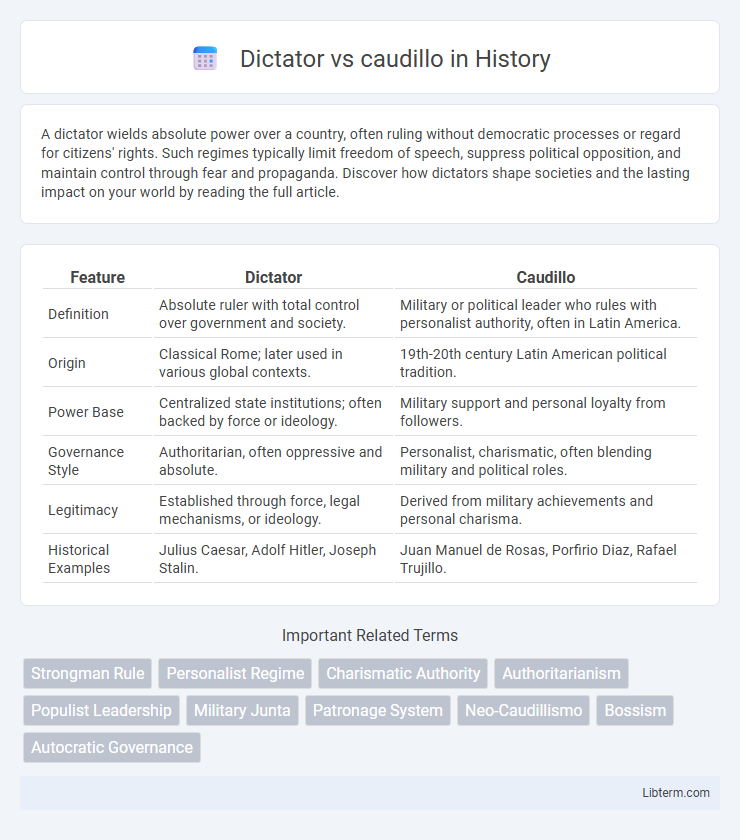A dictator wields absolute power over a country, often ruling without democratic processes or regard for citizens' rights. Such regimes typically limit freedom of speech, suppress political opposition, and maintain control through fear and propaganda. Discover how dictators shape societies and the lasting impact on your world by reading the full article.
Table of Comparison
| Feature | Dictator | Caudillo |
|---|---|---|
| Definition | Absolute ruler with total control over government and society. | Military or political leader who rules with personalist authority, often in Latin America. |
| Origin | Classical Rome; later used in various global contexts. | 19th-20th century Latin American political tradition. |
| Power Base | Centralized state institutions; often backed by force or ideology. | Military support and personal loyalty from followers. |
| Governance Style | Authoritarian, often oppressive and absolute. | Personalist, charismatic, often blending military and political roles. |
| Legitimacy | Established through force, legal mechanisms, or ideology. | Derived from military achievements and personal charisma. |
| Historical Examples | Julius Caesar, Adolf Hitler, Joseph Stalin. | Juan Manuel de Rosas, Porfirio Diaz, Rafael Trujillo. |
Definition of Dictator
A dictator is an authoritarian ruler who holds absolute power over a state or government, often obtained and maintained through force or coercion. Unlike a caudillo, whose authority may be based on personal charisma and military support within a specific cultural context, a dictator typically enforces centralized control without the need for traditional legitimacy. The term "dictator" historically refers to leaders exercising unchecked political power, limiting democratic institutions and civil liberties.
Definition of Caudillo
A caudillo is a military or political leader in Latin American history who exercises authoritarian control, often emerging from chaotic post-colonial contexts to establish personalist rule. Unlike a typical dictator defined primarily by centralized autocratic power, a caudillo often gains legitimacy through charisma, patronage networks, and populist support within rural or fragmented societies. This role intertwines military influence with traditional leadership, shaping governance through a mix of force, loyalty, and social ties.
Historical Origins of Dictatorship
The historical origins of dictatorship trace back to ancient Rome, where a dictator was an appointed magistrate granted absolute authority during emergencies, serving temporarily to restore order. In contrast, the concept of a caudillo emerged primarily in 19th-century Latin America, characterized by charismatic military leaders who seized and maintained power through personal loyalty and often authoritarian rule. While both embody centralized control, Roman dictatorship was institutional and limited in duration, whereas caudillismo evolved as a more persistent and personalized form of dictatorial governance tied to post-colonial political instability.
The Rise of Caudillos in Latin America
The rise of caudillos in Latin America during the 19th century was marked by military strongmen who combined personalist leadership with populist appeals, differing from conventional dictators through their regional influence and charismatic authority. Caudillos often emerged in the power vacuums following independence wars, leveraging loyalty from local militias and rural populations to challenge centralized state structures. Their rule significantly shaped political development by blending authoritarian control with localized governance, often resisting liberal reforms and fostering fragmented national identities.
Political Power Structures: Dictator vs Caudillo
Dictators exercise centralized political power often backed by authoritarian institutions, maintaining control through formal state mechanisms such as military and legal systems. Caudillos leverage charismatic leadership and personal loyalty within informal networks, often blending military influence with traditional or populist authority. The key difference lies in the dictator's emphasis on structured governance and institutional control versus the caudillo's reliance on personal charisma and regional power bases.
Leadership Styles and Ideologies
Dictators typically centralize power through authoritarian or totalitarian rule, emphasizing absolute control and often suppressing dissent to maintain stability. Caudillos, primarily found in Latin American contexts, combine military prowess with populist leadership, often appealing directly to personal loyalty rather than institutional authority. While dictatorsideologies lean toward imposing order and uniformity, caudillo leadership tends to blend charismatic authority with traditional or nationalist rhetoric, reflecting localized political and cultural dynamics.
Methods of Maintaining Control
Dictators maintain control through centralized authority, utilizing propaganda, censorship, and secret police to suppress dissent and enforce compliance. Caudillos rely heavily on personal loyalty, military power, and patronage networks to secure their rule, often using direct force and clientelism to manage political support. Both employ intimidation and control over media, but dictators tend to institutionalize repression, while caudillos emphasize charismatic leadership and regional influence.
Impact on Society and Governance
Dictators often centralize power through authoritarian regimes, suppressing opposition and limiting political freedoms, which can lead to societal fear and weakened democratic institutions. Caudillos, typically charismatic military leaders in Latin American history, blend personal loyalty with populist rule, impacting governance by prioritizing regional interests and traditional power structures over institutional reforms. Both forms of leadership frequently result in governance marked by instability, personalist rule, and challenges to social cohesion.
Famous Dictators and Caudillos
Famous dictators such as Adolf Hitler, Joseph Stalin, and Benito Mussolini centralized absolute power, often ruling through oppressive regimes and totalitarian control. Prominent caudillos like Juan Manuel de Rosas in Argentina, Porfirio Diaz in Mexico, and Rafael Trujillo in the Dominican Republic combined authoritarian rule with strong local military support and populist nationalism. Both dictators and caudillos managed to shape their nations' political landscapes through centralized authority, but caudillos often emerged in post-colonial Latin American contexts with a blend of military force and charismatic leadership.
Legacy and Contemporary Relevance
Dictators and caudillos both wielded authoritarian power but left distinct legacies shaped by cultural and historical contexts; dictators often institutionalized repression through centralized states, while caudillos exercised personalist rule rooted in military control and regional loyalties. Contemporary relevance lies in how modern authoritarian regimes draw from both models, blending centralized governance with populist militarism to maintain control. The legacy of caudillos is particularly pronounced in Latin America, where their influence continues to affect political structures and debates on legitimacy and governance.
Dictator Infographic

 libterm.com
libterm.com